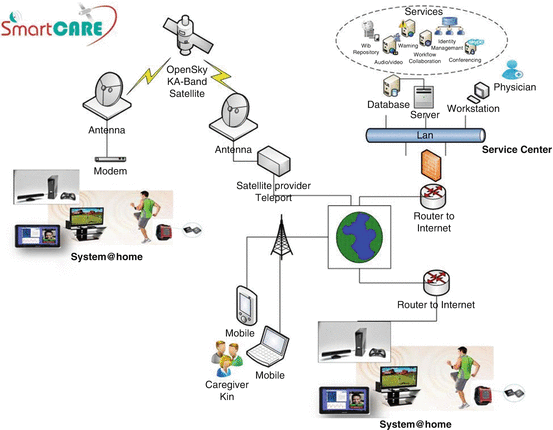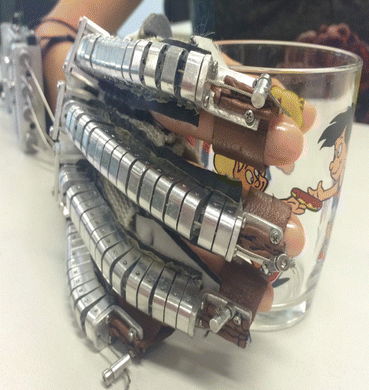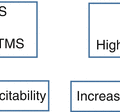Fig. 19.1
A conceptual schema of the system and the interaction among all the subsystems included in the platfv
Smart home technology can also aid in disease prevention—for example, providing inconspicuous memory aids, such as medication reminders, or refrigerators that can evaluate an inventory of contents and provide suggestions for menus, healthy choices, and a list of groceries that need to be purchased. Vibrating bracelets or audible prompters can remind people when to eat or when to go to the bathroom, and other wrist devices monitor pulse rates and skin temperature. Sensors and wireless devices are being used in homes to monitor individuals’ vital signs and whether medication has been taken, with this information sent wirelessly, through a sensor in the home or on the individual to the doctor or to family members—which is an added benefit for people who are homebound, are living in more remote rural areas, or are without immediate access to healthcare.
Several publications were identified about devices targeting:
- 1.
Social isolation (videophonic communication, affective orthotic devices or companion-type robots, personal emergency response systems [security])
- 2.
Autonomy loss (technologies for maintenance of autonomy in the ADL)
- 3.
To analyze and to use all these data, we can use the artificial intelligence and in particular the area of decision support systems (DSS) and intelligent DSS (IDSS) to focus on developing interactive software that can analyze data including specific domain knowledge and automatic reasoning capabilities and provide answers to the relevant decisional questions from the users, thus enhancing a person or group to make better decisions [11]. Creative use of information technologies should facilitate the organization, presentation, and integration of this information to obtain individualized and systematic clinical decisions, predicated on individual patient’s priorities [12]. The capability to provide a distance-based service is expected to eliminate barriers (e.g., logistical, geographical, administrative, etc.) that are currently hindering a stronger penetration of “traditional” hospitalized rehabilitation services (Fig. 19.2).


Fig. 19.2
Conceptual design of intelligent decision support system (IDSS)
The use of ICT and domotics in general is changing the paradigm, extending with no limit the coverage area, and therefore allowing for a strong economy of scale. One of the barriers to the diffusion of e-Health is the digital divide, as the difficulty/inability of access to the network (in this case we talk about the digital divide “absolute”) as well as a lack of basic knowledge enabling the use of digital technologies. The resources and satellite telecommunication services allow filling in the gaps and delays in the spread of broadband: on the one hand, they are the only possible solution to the digital divide absolute (pure scenery satellite) and, on the other hand, they can increase the quality of telecommunications, where digital terrestrial service is already available (hybrid terrestrial and satellite scenario) [10] (Fig. 19.3).


Fig. 19.3
SmartCare project architectures
19.4 Rehabilitation Robotics
In the field of telemedicine, robotic devices were used to help and improve the motor performance in older subjects. Rehabilitation robotics (RR) and the assistive robotics (AA) are branches of robotics, which focus on devices or machines that can help people with disability to recover and provide support in case of severe disability or physical trauma. It is unclear when this specialty was born, but the first clinical robot applications were powered human exoskeleton devices in the 1960s.
The RR and AA devices can be classified as exoskeleton, end effector, and wearable. All these robots are designed around the function and shape of the human body while the human is able to control the robotic limbs.
Numerous robotic devices for the upper and lower limb and hand function with various levels of complexity and functionality have been developed over the last 20 years. In this field, clinicians, therapists, and engineers collaborate to help the subjects with the impairments. Prominent goals in this field include developing implementable technologies that can be easily used by patients, therapists, and clinicians; enhancing the efficacy of clinician’s therapies; and increasing the ease of activities in daily life.
The development of robot-aided tools for geriatric rehabilitation is a very stimulating prospective when considering their highly rehabilitative and assistive potentials. The main characteristics of all robot-aided treatment are the possibility to administer high-intensity and repetitive therapy. In fact, chronic subjects showed significant improvement in motor functions with intensive robot-assisted training, which may supplement the standard multidisciplinary rehabilitation programs, as our studies demonstrated [13, 14]. In particular, various robotic devices that assist and train upper extremity movements and hand function with various levels of complexity and functionality have been developed in the last 10 years. These devices range from simple mechanisms that support single-joint movements to more complex mechanisms with as many as 18 degrees-of-freedom (DOF) for multi-joint movements of the wrist and fingers.
The first results from clinical studies indicate that robot-assisted hand rehabilitation reduces motor impairments of the affected hand and the arm and improves the functional use of the affected hand. The different motor impairments of the hand can be viewed as resulting from problems in either motor execution or motor planning/learning. Deficits in motor execution result from weakness of wrist/finger extensors, overactive wrist/finger flexors (increased tone and spasticity), co-contraction, impaired finger independence, poor coordination between grip and load forces, inefficient scaling of grip force and peak aperture, and delayed preparation, initiation, and termination of object grip (Fig. 19.4).








